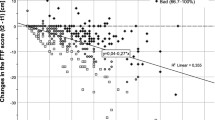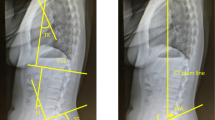Abstract
The Self-Efficacy Scale (SES) has been found to predict isokinetic performance better than anthropometric variables. This study tests the predictive power of SES further against other measures of efficacy expectancies as well as measures of depression and perceived disability. A group of 105 chronic back pain patients was administered Beck's Depression Inventory (BDI), SES, the Pain Self-Efficacy Questionnaire (PSEQ), and the Oswestry low back pain disability questionnaire (OSWESTRY). Total isokinetic work done was measured at slow, medium and high speeds, for which multiple regression models were fitted controlling for sex, age, weight and height. The results confirmed SES to be the best overall predictor of isokinetic performance. BDI was not significant as a predictor of isokinetic performance. The models also revealed that SES predicts less well with increases in the test speed, particularly in extension. These results provide further evidence of the diagnostic value of SES relative to OSWESTRY and PSEQ.
Similar content being viewed by others
References
Bigos SJ, Battié M, Spengler DM,et al. A prospective study of work perceptions and psychosocial factors affecting the report of back injury.Spine 1991; 16: 1–6.
Frymoyer JW, Cats-Baril W. Predictors of low back pain disability.Clin Orthop Relat Res 1987; 221: 89–98.
Riihimäki H. Low-back pain, its origin and risk indicators.Scand J Work Env Health 1991; 17: 81–90.
Newton M, Waddell G. Trunk strength testing with iso-machines: Part 1: Review of a decade of scientific evidence.Spine 1993; 18: 801–811.
Bandura A. Self-efficacy: Toward a unifying theory of behavioral change.Psychol Rev 1977; 84: 191–215.
Dolce JJ. Self-efficacy and disability beliefs in behavioral treatment of pain.Behav Res Ther 1987; 25: 289–299.
Council JR, Ahern DK, Follick MJ, Kline CL. Expectancies and functional impairment in chronic low back pain.Pain 1988; 33: 323–331.
Kirsch I. Response expectancy as a determinant of experience and behavior.Am Psychol 1985; 40: 1189–1202.
Palenzuela DL. The expectancy construct within the social learning theories of Rotter and Bandura: A reply to Kirsch's approach.J Soc Behav Person 1987; 2: 437–452.
Estlander A-M, Vanharanta H, Moneta GB, Kaivanto K. Anthropometric variables, self-efficacy beliefs, and pain and disability ratings on the isokinetic performance of low back pain patients.Spine 1994; 19: 941–947.
Bongers PM, de Winter CR, Kompier MAJ, Hildebrandt VH. Psychosocial factors at work and musculoskeletal disease.Scand J Work Env Health 1993; 19: 297–312.
Beck AT, Ward CH, Mendelson M, Mock J, Erbaugh J. An inventory for measuring depression.Arch Gen Psychiat 1961; 4: 561–571.
Husman K. Symptoms of car-painters with long-term exposure to a mixture of organic solvents.Scand J Work Env Health 1980; 6: 19–32.
Hänninen H.Neurotoksisten Haittojen Seulonta: Oirekyselyt ja Psykologiset Testit (The screening of neuro-toxic effects: Symptom questionnaires and psychological tests). Helsinki: Työterveyslaitos, 1989.
Nicholas MK Self-Efficacy and Chronic Pain. Paper presented at the Annual Conference of the British Psychological Society, St. Andrews, March 1989.
Fairbanks JCT, Couper J, Davies JB, O'Brien JP. The Oswestry Low Back Pain Disability Questionnaire.Physiotherapy 1980; 66: 271–273.
Nicholas MK, Wilson PH, Goyen J. Comparison of cognitive-behavioral group treatment and an alternative non-psychological treatment for chronic low back pain.Pain 1992; 48: 339–347.
Norusis MJ.SPSS/PC+™ V2.0 base manual for the IBM PC/XT/AT and PS/2. Chicago: SPSS, 1988.
Weisberg S.Applied Linear Regression (2nd Ed.). New York: John Wiley & Sons, 1985.
Rissanen A, Kalimo H, Alaranta H. Muscle histomorphology and isokinetic strength: A prospective study of intensive training in chronic low back pain patients. In:Book of abstracts of the international society for the study of the lumbar spine; 1993 June 15–19. Marseilles:International Society for the Study of the Lumbar Spine, 1993.
Author information
Authors and Affiliations
Rights and permissions
About this article
Cite this article
Kaivanto, K.K., Estlander, A.M., Moneta, G.B. et al. Isokinetic performance in low back pain patients: The predictive power of the Self-Efficacy Scale. J Occup Rehab 5, 87–99 (1995). https://doi.org/10.1007/BF02109912
Issue Date:
DOI: https://doi.org/10.1007/BF02109912




